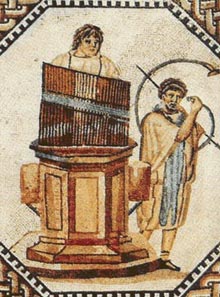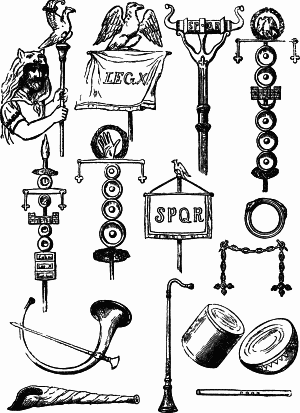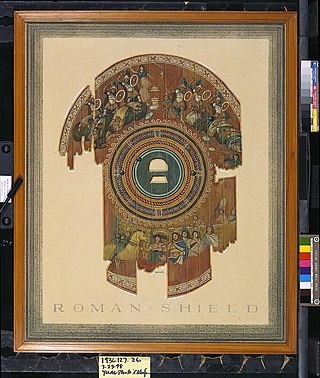
A shield is a piece of personal armour held in the hand, which may or may not be strapped to the wrist or forearm. Shields are used to intercept specific attacks, whether from close-ranged weaponry or projectiles such as arrows, by means of active blocks, as well as to provide passive protection by closing one or more lines of engagement during combat.
The pilum was a javelin commonly used by the Roman army in ancient times. It was generally about 2 m long overall, consisting of an iron shank about 7 mm (0.28 in) in diameter and 600 mm (24 in) long with a pyramidal head, attached to a wooden shaft by either a socket or a flat tang.

Medieval architecture was the art of designing and constructing buildings in the Middle Ages. Major styles of the period include pre-Romanesque, Romanesque, and Gothic. The Renaissance marked the end of the medieval period, when architects began to favour classical forms. While most surviving medieval constructions are churches and military fortifications, examples of civic and domestic architecture can be found throughout Europe, including in manor houses, town halls, almshouses, bridges, and residential houses.

The scutum was a type of shield used among Italic peoples in antiquity, most notably by the army of ancient Rome starting about the fourth century BC.

Imago clipeata is a term in the art history of ancient Rome for images of ancestors, famous people or deceased shown as on a round shield. For other periods similar forms are called medallions. In the Roman world the imago clipeata was used to depict the ancestral family tree in patrician houses of the Roman Republic as described by Pliny the Elder.
The limitanei, meaning respectively "the soldiers in frontier districts" or "the soldiers on the riverbank", were an important part of the late Roman and early Byzantine army after the reorganizations of the late 3rd and early 4th centuries. The limitanei, unlike the Comitatenses, palatīni, and Scholae, garrisoned fortifications along the borders of the Roman Empire and were not normally expected to fight far from their fortifications.

The thyroid cartilage is the largest of the nine cartilages that make up the laryngeal skeleton, the cartilage structure in and around the trachea that contains the larynx. It does not completely encircle the larynx.

A cornu or cornum was an ancient Roman brass instrument about 3 m (9.8 ft) long in the shape of a letter 'G'. The instrument was braced by a crossbar that stiffened the structure and provided a means of supporting its weight on the player's shoulder. Some specimens survive in the archaeological record, two from the ruins of Pompeii.
A parma or parmula was a type of round shield used by the Roman army, especially during the later period of imperial history since the 3rd century.

Roman military personal equipment was produced in large numbers to established patterns, and used in an established manner. These standard patterns and uses were called the res militaris or disciplina. Its regular practice during the Roman Republic and Roman Empire led to military excellence and victory. The equipment gave the Romans a very distinct advantage over their barbarian enemies, especially so in the case of armour. This does not mean that every Roman soldier had better equipment than the richer men among his opponents. Roman equipment was not of a better quality than that used by the majority of Rome's adversaries. Other historians and writers have stated that the Roman army's need for large quantities of "mass produced" equipment after the so-called "Marian Reforms" and subsequent civil wars led to a decline in the quality of Roman equipment compared to the earlier Republican era:
The production of these kinds of helmets of Italic tradition decreased in quality because of the demands of equipping huge armies, especially during civil wars...The bad quality of these helmets is recorded by the sources describing how sometimes they were covered by wicker protections, like those of Pompeius' soldiers during the siege of Dyrrachium in 48 BC, which were seriously damaged by the missiles of Caesar's slingers and archers.
It would appear that armour quality suffered at times when mass production methods were being used to meet the increased demand which was very high the reduced size cuirasses would also have been quicker and cheaper to produce, which may have been a deciding factor at times of financial crisis, or where large bodies of men were required to be mobilized at short notice, possibly reflected in the poor-quality, mass produced iron helmets of Imperial Italic type C, as found, for example, in the River Po at Cremona, associated with the Civil Wars of AD 69 AD; Russell Robinson, 1975, 67
Up until then, the quality of helmets had been fairly consistent and the bowls well decorated and finished. However, after the Marian Reforms, with their resultant influx of the poorest citizens into the army, there must inevitably have been a massive demand for cheaper equipment, a situation which can only have been exacerbated by the Civil Wars...
The Goths, Gepids, Vandals, and Burgundians were East Germanic groups who appear in Roman records in late antiquity. At times these groups warred against or allied with the Roman Empire, the Huns, and various Germanic tribes.

The Eastern Roman army refers to the army of the eastern section of the Roman Empire, from the empire's definitive split in 395 AD to the army's reorganization by themes after the permanent loss of Syria, Palestine and Egypt to the Arabs in the 7th century during the Byzantine-Arab Wars. The East Roman army was the continuation of the Late Roman army of the 4th century, until it gradually transformed into what is now called the Byzantine army from the 7th century onwards.
The palatini were elite units of the Late Roman army mostly attached to the comitatus praesentales, or imperial escort armies. In the elaborate hierarchy of troop-grades, the palatini ranked below the scholares, but above the comitatenses and the limitanei.

Triarii were one of the elements of the early Roman military manipular legions of the early Roman Republic. They were the oldest and among the wealthiest men in the army and could afford high quality equipment. They wore heavy metal armor and carried large shields, their usual position being the third battle line. They were equipped with spears and were considered to be elite soldiers among the legion.
A round shield can refer to any type of hand-held shield that has a round shape. They come in highly varying sizes, and have, in different forms, been very popular in Europe, the Asia and the Americas, throughout the Bronze Age, the classical period, the post-classical period, and the early modern period. During the Bronze Age they were generally large and designed for bashing and shield wall tactics, while since the late post-classical they were mostly designed for parrying and riposte.

The Late Roman ridge helmet was a type of combat helmet of Late Antiquity used by soldiers of the Late Roman army. It was characterized by the possession of a bowl made up of two or four parts, united by a longitudinal ridge.

A medallion is a round or oval ornament that frames a sculptural or pictorial decoration in any context, but typically a façade, an interior, a monument, or a piece of furniture or equipment.

The scutum from Dura-Europos is the only surviving semi-cylindrical shield (scutum) from Roman times. It is now in the Yale University Art Gallery. The shield was found in the excavation campaign of 1928/37 on Tower 19 of Dura-Europos. The city was besieged by the Sassanids in 256, eventually captured and destroyed. The dry climate enables very good conservation conditions for organic materials such as wood. Since the city housed a Roman garrison and was lost during a siege, a particularly large number of weapons were found during the excavations.

The Homeric shield is one of three figural painted shields found together in an embankment within a Roman garrison during the excavations of Dura-Europos. Dura-Europos was a border city of various empires throughout antiquity, and in modern archaeology is noteworthy for its large amount of well-preserved artifacts. Having been virtually untouched for centuries, and with favorable soil, an unusual amount of organic material has been preserved at Dura-Europos. This shield and those found alongside it date from the middle of the 3rd century CE, a period in which a large portion of the city was co-opted as a Roman military base. The shields were deliberately discarded unfinished during the Sassanian siege of Dura Europos. It is widely believed to depict two scenes from the Trojan war: the admission of the Trojan horse into Troy, and the subsequent sack of the city. It is one of few examples of Roman painting on wood, and one of very few Roman painted wooden shields to have survived from antiquity. The shield has now deteriorated beyond most detail being discernible to the naked eye. This is due to the unintended adverse effects of a binding agent applied to the shield in the 1930s in the hopes of preserving the pigmentation.















